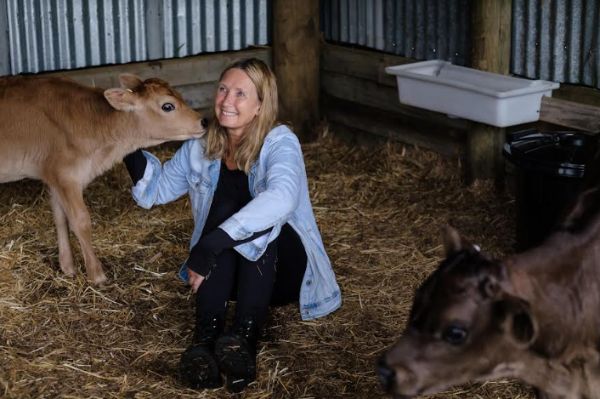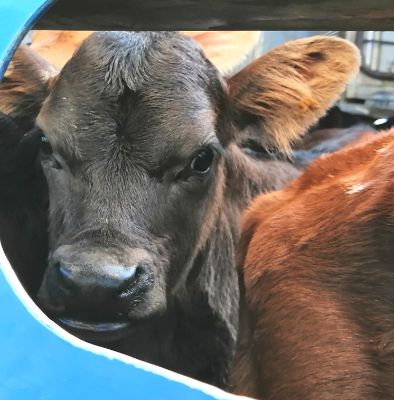Bobby Calves Are Not The Problem – The Dairy Industry Is!
It’s that time of year again when the majority of bobby calves born on farms in Aotearoa New Zealand will be transported to slaughterhouses and killed.
Since 2014 I have run a bobby calf rescue organisation called Starfish Bobby Calf Project that takes aim at the dairy industry. In partnership with other rescues, we save just a handful of tiny bobby calves and rehome to vetted permanent families.

It is not even a drop in the vast ocean of endless young calves that get sent to their deaths each year. So in addition to rescue I also agitate and protest against the dairy industry.
Last year in Aotearoa New Zealand 1,872,815 bobby calves were killed at slaughterhouses across the country. This year it is shaping up to look very similar. It’s been the same for quite a few years now.
Their deaths remain unmarked as they are reduced to a sad pile of blood, organs and bones. They are mostly turned into pet food. Occasionally they are sent overseas packaged as veal.
Their lives are over before they have even begun. Bobby calves are the unwanted by-product of milk production. In order for a cow to produce milk she must first give birth to a calf. Many of these calves across Aotearoa New Zealand are surplus to the requirements of the dairy farm they are born on.
These calves become ‘bobbies’. Their invisibility is disturbing as they get transported to slaughterhouses in their hundreds of thousands over any single year. The busiest months are July through to September. Last year 945, 778 were killed in the month of August alone. New Zealand is the only country in the world to kill such a large group of calves in a short period of time.

I believe that people have a right to know how their food is produced before choosing to purchase and consume it. Most people in Aotearoa New Zealand do care for animals and their welfare. In which case, they should learn about the unavoidable suffering behind consuming dairy. This includes milk chocolate, yoghurt, milk, cheese and many other products.
There are alternatives that are delicious and don’t include the cruelty. Have a look at these dairy swaps put out by SAFE for some ideas.
The reality of dairy production is deeply problematic in terms of ‘animal welfare’. On a very basic level, the immediate and obvious problem is that dairy products are made from milk. In order for a cow to produce milk, she must first get pregnant and have a calf. That calf is now surplus to requirements – the milk meant for him (or her) is to be redirected for human consumption and industry profit.
So, what happens to the calves? The calves not wanted for replacement herd or to ‘grow on’ or sell for beef production are sent on the bobby truck to their deaths between 4-10 days of age. It’s brutal.
To make it even sadder, the regulations governing their short lives do not protect them from suffering.
The regulations put out by the Ministry of Primary Industries (MPI) regarding bobby calves include two worrying statements:
Firstly, the maximum journey time for young calves is 12 hours.
Secondly, young calves must be slaughtered within 24 hours of the last feed on farm.
What this means is that it is legal to transport calves of less than a week old for 12 hours. That is quite frankly horrific. These are neonates who are vulnerable and programmed biologically to suckle regularly and be close to their mothers. Instead, ripped from their mothers they now must endure a trip on a noisy, filthy and moving truck for hours on end. It must be hell.
In addition to this systemic suffering, it is evident that slaughterhouses are no picnic. A 2015 expose by Farmwatch graphically revealed the suffering that bobby calves are forced to endure before they die. Thrown on to trucks, slammed into concrete floors and bludgeoned to death these calves suffered horrifically. It brought the issue of bobby calves squarely into the public eye – both nationally and internationally.
The Ministry for Primary Industries (MPI) went into damage control. Industry groups that had formed a Bobby Calf Action Group in late 2015. In 2017 the then Minister for Primary Industries Nathan Guy released a report stating that “recently there has been increased public concern over the fate of surplus or ‘bobby’ calves”. This report focused on increasing bobby calf welfare to reduce their mortality rate. It stated that there had been major improvements in bobby calf welfare in the previous year. He detailed that the mortality rate for bobby calves sent to slaughter had halved last year – from 0.25 per cent to 0.12 per cent.
The reduction in bobby calf deaths prior to being slaughtered has repeatedly been hailed as a success story by MPI. For example, a news release by the New Zealand Government in 2018 stated that “the number of bobby calves that die between the farm gate and the works is now down to 6 calves for every 10,000 and that is a victory for our animal welfare regulations, says the Associate Minister of Agriculture responsible for Animal Welfare Hon Meka Whaitiri.”
A victory? The calves were on their way to be killed regardless. The irony of using the calves’ mortality as a measure of their welfare is jarring. These calves are being killed in their first week of life. The focus should be on cutting this cruel practice out entirely.
And to be fair, this is another step the industry took. Recent media reports detailed a focus on zero bobbies by selling the calves on as ‘dairy beef’. Using sexed semen is another avenue being used – although it should be noted that many bobby calves are female.
In a report released by Kellogg Rural Leadership Programme in 2021, Greg Hamill argues that bobby calves are a ‘problem’ and an ‘ethical issue’ in Aotearoa New Zealand. In a startling statement Hamill reveals the rather industry-serving intent of the report:
“We are currently flying below the radar, we only need someone to step up and make a crusade about bobby calves and we’ll be back in the headlines nationally and internationally and be forced to address the situation fully to protect our national and international markets, or potentially face being regulated”.
I’m sorry, did Hamill just suggest that we ‘fully address’ the issue of bobby calves to protect our national and international markets? Is that the main reason their short-term welfare matters? Where is the ethics in that?
Hamill goes on to look for ways to avoid this issue by getting “more revenue and value from these animals by growing them out to a larger size and / or developing markets and additional opportunities that deliver a better outcome”.
A better outcome for whom? Certainly not the calves. The focus in all of these solutions to the problem of bobby calves is located in the same market-based logic that brings these calves into existence in the first place.
In my view, bobby calves are not a commodity or a market opportunity. They are sentient beings who never asked to be born. We have an ethical responsibility when breeding animals to ensure they do not suffer at the very least. The MPI regulations do not protect bobby calves from suffering. No amount of market-based logic is going to solve this problem.
Bobby calves are not the problem – the dairy industry is. It is unsustainable in terms of the environment and animal wellbeing.
At the very least it’s time the public demanded better from the dairy industry and MPI. They should be accountable to the values they espouse of high animal welfare.
Ultimately, however, the dairy industry should be replaced with new opportunities for farmers to make a profit and feed the world based on regenerative agriculture. It’s better for the planet, our health and animals.


 Gordon Campbell: On The Left’s Electability Crisis, And The Abundance Ecotopia
Gordon Campbell: On The Left’s Electability Crisis, And The Abundance Ecotopia YWCA: Global Push Back Against Gender Equality A Growing Crisis In Aotearoa
YWCA: Global Push Back Against Gender Equality A Growing Crisis In Aotearoa Te Pāti Māori: Ngarewa-Packer - Fast-Tracking Seabed Mining Ignores Māori Opposition And Environmental Precedent
Te Pāti Māori: Ngarewa-Packer - Fast-Tracking Seabed Mining Ignores Māori Opposition And Environmental Precedent New Zealand Defence Force: Defence And Customs Strengthen Maritime Security With Uncrewed Surface Vessels
New Zealand Defence Force: Defence And Customs Strengthen Maritime Security With Uncrewed Surface Vessels SPCA: Huge Win With New Dog Tethering Regulations
SPCA: Huge Win With New Dog Tethering Regulations Community Housing Aotearoa: Ngā Wharerau o Aotearoa Says New Partnership Model Helping Ensure Right To A Decent Home Is Realised
Community Housing Aotearoa: Ngā Wharerau o Aotearoa Says New Partnership Model Helping Ensure Right To A Decent Home Is Realised Greenpeace Aotearoa: Babies At Risk Due To Nitrate-Contaminated Drinking Water In Ashburton District
Greenpeace Aotearoa: Babies At Risk Due To Nitrate-Contaminated Drinking Water In Ashburton District


